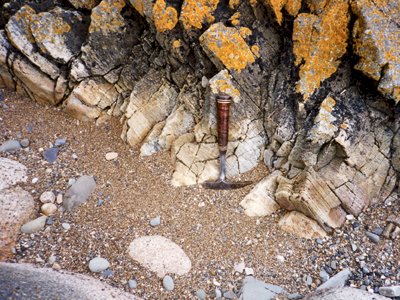Earth Science Conservation Review
| Mournes - Dyke No 124 at Samuel's Port, Annalong | Down |
| Site Type: | Coastal section |
| Site Status: | ASSI |
| Council area: | Newry & Mourne District Council |
| Grid Reference: | J365181 |
| Google maps: | 54.0944,-5.91363 |
| Rocks | |
|---|---|
| Rock Age: | Tertiary (Eocene) |
| Rock Name: | Granite |
| Rock Type: | Basalt, Gabbro, Porphyry, Tholeiite |
| Interest | |
| Other interest: | dyke, xenoliths, Intrusion, Boat slips cross the beach to the north. |
Summary of site:
In 1935 Tomkeieff and Marshall mapped and described the swarm of dykes along the coast east of the Mourne Mountains. For purposes of identification they numbered them and this description is of a multiple (more than one dyke) and composite (one intrusion within another) dyke in Samuel's Port near Annalong, bundled together as dyke 124.
The first two intrusions were an olivine dolerite dyke to the south and a basalt dyke to the north. They are separated by a third, later, dyke so the age relationship between the dolerite and basalt is not clear. The dolerite dyke has chilled margins, resulting in a finer grainsize.
The basalt dyke to the north is a composite and 11 m of feldspar porphyry (a rock with prominent feldspar crystals in a finer matrix) separates a 30 cm basalt margin to the south from one 2.7 m wide to the north. The feldspar porphyry between is reddish in colour and there is some mixing of the basalt and porphyry showing that both were mobile at the time. This intrusion of a rock of granitic composition into still molten basalt is of considerable interest.
The third dyke, separating the dolerite and basalt and chilled at its margins against both, is a tholeiite, a basalt rich in silica that normally forms plateau basalts, the most plentiful type. This intrusion is of exceptional interest because it contains chunks (xenoliths) up to 13 cm across of both granite and gabbro (coarse-grained acid and basic rocks respectively).
This dyke complex shows that two entirely contrasting molten rocks, acid (granite and feldspar porphyry) and basic (gabbro and basalt), existed at the same time and mixed to form intermediate types. Of special interest is the tholeiitic basalt because it contains both granite and, uniquely here, gabbro.
Access to the site is straightforward along the shore from the north. There are no threats to dyke 124.
The first two intrusions were an olivine dolerite dyke to the south and a basalt dyke to the north. They are separated by a third, later, dyke so the age relationship between the dolerite and basalt is not clear. The dolerite dyke has chilled margins, resulting in a finer grainsize.
The basalt dyke to the north is a composite and 11 m of feldspar porphyry (a rock with prominent feldspar crystals in a finer matrix) separates a 30 cm basalt margin to the south from one 2.7 m wide to the north. The feldspar porphyry between is reddish in colour and there is some mixing of the basalt and porphyry showing that both were mobile at the time. This intrusion of a rock of granitic composition into still molten basalt is of considerable interest.
The third dyke, separating the dolerite and basalt and chilled at its margins against both, is a tholeiite, a basalt rich in silica that normally forms plateau basalts, the most plentiful type. This intrusion is of exceptional interest because it contains chunks (xenoliths) up to 13 cm across of both granite and gabbro (coarse-grained acid and basic rocks respectively).
This dyke complex shows that two entirely contrasting molten rocks, acid (granite and feldspar porphyry) and basic (gabbro and basalt), existed at the same time and mixed to form intermediate types. Of special interest is the tholeiitic basalt because it contains both granite and, uniquely here, gabbro.
Access to the site is straightforward along the shore from the north. There are no threats to dyke 124.
| Enlander, I., Dempster, M. & Doughty, P., 2025. Mournes - Dyke No 124 at Samuel's Port, Annalong, County Down, site summary. [In] Earth Science Conservation Review. https://www.habitas.org.uk/escr/summary.php?item=1108. Accessed on 2025-04-03 |
| Previous Site | Next Site |



